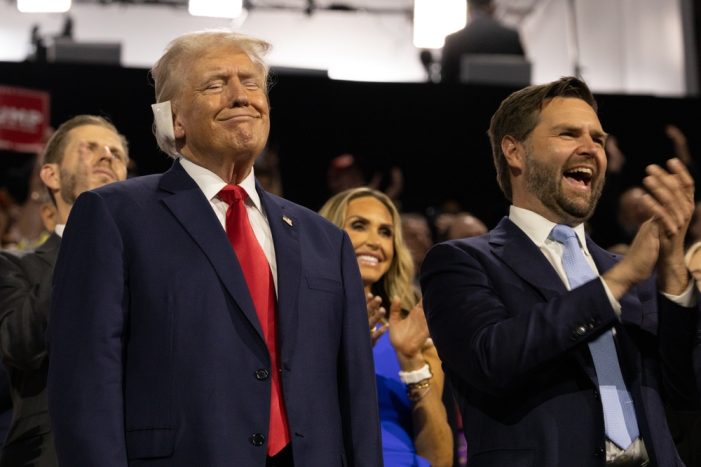By Brian Figeroux, Esq. | Editorial credit: Maxim Elramsisy/shutterstock.com
In 2024, Donald Trump and JD Vance’s political rhetoric has sparked significant controversy, with numerous statements and public remarks that have been interpreted as racially charged or even racist.
In 2024, Donald Trump and JD Vance’s political rhetoric sparked significant controversy, with numerous statements and public remarks that have been interpreted as racially charged or even racist. Their speeches and the comments from supporters that they often condone have been heavily scrutinized for promoting divisive narratives, particularly in the context of immigration, minority communities, and crime.
Trump’s approach to race-related issues has been a focal point throughout his political career, and in 2024, he continued to make comments that many interpreted as racist. During a campaign rally in Wisconsin, Trump made inflammatory claims regarding immigrants, stating that illegal immigration had drastically worsened under the Biden administration. These comments reinforced his 2016 rhetoric, where he famously referred to Mexican immigrants as “rapists” and criminals. In the 2024 election cycle, he once again suggested that immigrants from certain countries, particularly non-white majority nations, are responsible for societal decay and economic hardship. These comments play into long-standing fears of “otherness,” stoking xenophobic sentiments among his base.
At the same time, JD Vance, as Trump’s running mate, has echoed similar themes. Vance, who had previously criticized Trump before embracing his platform, has been known to amplify unfounded rumors about immigrant communities. For instance, in Ohio, Vance continued to spread a false conspiracy theory claiming that immigrants in the state were responsible for eating pets, a comment that was widely condemned as racially charged and dehumanizing. Despite pushback, Vance maintained his stance, fueling racial tension and reinforcing harmful stereotypes about immigrant communities. According to media reports, Vance’s continued endorsement of this false narrative, even after it was debunked, contributed to a toxic political environment, with local officials reporting threats and unrest in communities impacted by these baseless claims.
Trump and Vance’s rhetoric extends to their discourse about crime, particularly when discussing urban areas with large Black and Latino populations. During rallies, Trump and Vance have repeatedly suggested that crime rates are out of control in these areas, blaming it on lax immigration policies and the alleged failures of Democratic leadership. These statements have drawn sharp criticism for their racial undertones, as they often link minority populations with criminality in a manner that oversimplifies complex social issues and fuels negative racial stereotypes.
Both Trump and Vance have also positioned themselves as defenders of “traditional American values,” a phrase that, in their political context, is often a dog whistle for policies that marginalize minority groups. Their speeches often highlight the perceived threats posed by “woke” culture, which they argue promotes minority rights at the expense of white, working-class Americans. This rhetoric has been criticized for exacerbating racial and cultural divisions and playing into the politics of resentment.
Such rhetoric, particularly when repeated and amplified by supporters, pushes the boundaries of protected speech under the First Amendment. While Trump and Vance argue that they are exercising their right to free speech and discussing legitimate political issues, critics contend that their comments incite racial hatred and can lead to real-world harm. Legal scholars have debated whether their repeated use of racially charged language, which is often not directly linked to policy proposals but rather to stirring up fear and division, could fall under the category of unprotected speech, particularly if it incites violence or discrimination.
News outlets like CNN, Reuters, and The Wall Street Journal have reported extensively on these developments, with fact-checking organizations calling out many of Trump and Vance’s claims false or misleading. For instance, Reuters analyzed Trump’s speech in Wisconsin, highlighting numerous false claims, including his assertions about immigrant crime rates and his exaggerated success in curbing illegal immigration during his presidency. Similarly, PolitiFact debunked claims made by Vance regarding immigrants in Ohio, noting that his statements were not only false but also harmful in their portrayal of immigrant communities.
In conclusion, the statements made by Donald Trump and JD Vance in the 2024 election cycle have frequently been interpreted as racially insensitive or even outright racist. Their rhetoric, often based on false or exaggerated claims, has had a divisive impact on the national conversation about race, immigration, and crime. While they argue that they are engaging in free speech, the racially charged nature of their remarks has led to widespread condemnation, with some critics suggesting that their speech crosses into the realm of unprotected speech due to its potential to incite harm. The media coverage surrounding these comments continues to play a crucial role in holding them accountable, exposing the factual inaccuracies and dangerous implications of their rhetoric.

